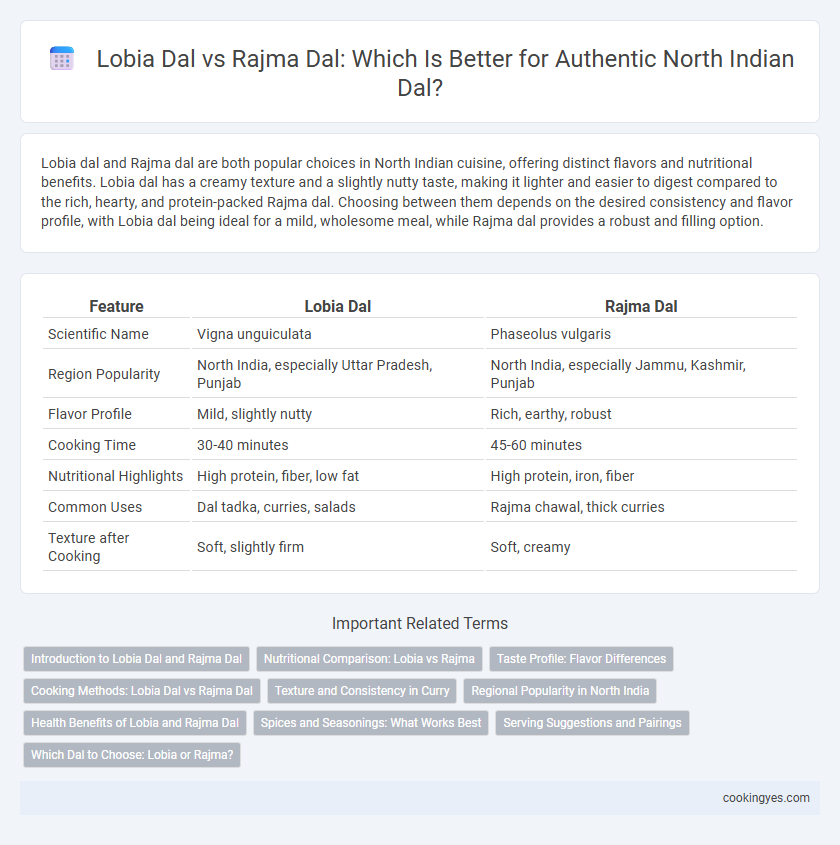Lobia dal and Rajma dal are both popular choices in North Indian cuisine, offering distinct flavors and nutritional benefits. Lobia dal has a creamy texture and a slightly nutty taste, making it lighter and easier to digest compared to the rich, hearty, and protein-packed Rajma dal. Choosing between them depends on the desired consistency and flavor profile, with Lobia dal being ideal for a mild, wholesome meal, while Rajma dal provides a robust and filling option.
Table of Comparison
| Feature | Lobia Dal | Rajma Dal |
|---|---|---|
| Scientific Name | Vigna unguiculata | Phaseolus vulgaris |
| Region Popularity | North India, especially Uttar Pradesh, Punjab | North India, especially Jammu, Kashmir, Punjab |
| Flavor Profile | Mild, slightly nutty | Rich, earthy, robust |
| Cooking Time | 30-40 minutes | 45-60 minutes |
| Nutritional Highlights | High protein, fiber, low fat | High protein, iron, fiber |
| Common Uses | Dal tadka, curries, salads | Rajma chawal, thick curries |
| Texture after Cooking | Soft, slightly firm | Soft, creamy |
Introduction to Lobia Dal and Rajma Dal
Lobia Dal, also known as black-eyed pea dal, is a nutrient-rich legume commonly used in North Indian cuisine, valued for its high protein content and earthy flavor. Rajma Dal, or red kidney bean dal, features prominently in North Indian households, known for its robust taste and creamy texture when cooked. Both dals provide essential dietary fiber, iron, and folate, making them staple pulses in traditional North Indian meals.
Nutritional Comparison: Lobia vs Rajma
Lobia dal offers a high protein content of approximately 24 grams per 100 grams, making it a rich source of plant-based protein, while rajma dal provides around 22 grams per 100 grams with slightly higher dietary fiber levels. Rajma dal contains more carbohydrates, about 60 grams per 100 grams, compared to lobia's 55 grams, contributing to better energy provision. Both dals are rich in essential minerals, but lobia has higher iron content, supporting improved blood health in North Indian diets.
Taste Profile: Flavor Differences
Lobia Dal has a mild, buttery taste with a slightly sweet undertone, making it a soothing choice for North Indian dal dishes. Rajma Dal offers a robust, earthy flavor with a hint of nuttiness, providing a richer and heartier taste experience. Both dals complement traditional spices but cater to different palates due to their distinct flavor profiles.
Cooking Methods: Lobia Dal vs Rajma Dal
Lobia dal requires a shorter soaking time, typically 4-6 hours, whereas rajma dal benefits from an overnight soak of 8-12 hours for optimal texture. Cooking lobia dal involves simmering for 30-40 minutes until tender, often using a pressure cooker to reduce time, while rajma dal usually needs 45-60 minutes of slow cooking to fully soften the kidney beans. Both dals absorb spices well, but lobia dal's softer skin allows for quicker infusion, whereas rajma dal's denser texture demands longer cooking to achieve a creamy consistency.
Texture and Consistency in Curry
Lobia dal offers a soft texture with a slightly creamy consistency, making it ideal for smooth North Indian dal curries that easily absorb spices. Rajma dal is thicker and more robust, providing a dense, hearty curry base with a grainier texture. Both dals enrich North Indian cuisine but differ in mouthfeel, where lobia yields a silkier curry and rajma delivers a more substantial bite.
Regional Popularity in North India
Lobia Dal and Rajma Dal hold distinct places in North Indian cuisine, with Rajma Dal being the more regionally popular choice, especially in Punjab and Uttar Pradesh due to its rich, creamy texture and robust flavor. Lobia Dal, though less widespread, enjoys popularity in select North Indian communities for its lighter taste and quicker cooking time. The regional preference for Rajma Dal is often linked to traditional pairings with steamed rice and its nutritional richness in protein and fiber.
Health Benefits of Lobia and Rajma Dal
Lobia dal is rich in dietary fiber, iron, and protein, promoting digestive health and maintaining stable blood sugar levels, making it an excellent choice for diabetes management. Rajma dal offers high antioxidant content and is a great source of folate and magnesium, supporting heart health and reducing inflammation. Both dals provide plant-based protein and essential nutrients, but lobia's iron content is particularly beneficial for combating anemia common in North Indian populations.
Spices and Seasonings: What Works Best
Lobia Dal and Rajma Dal, staples in North Indian cuisine, each require distinct spice blends to enhance their unique flavors. Lobia Dal pairs well with aromatic spices like cumin, turmeric, and coriander powder, complemented by a tempering of garlic and dried red chilies for a mildly spicy profile. Rajma Dal benefits from robust seasonings such as garam masala, bay leaves, and ginger, creating a rich, earthy taste favored in hearty North Indian meals.
Serving Suggestions and Pairings
Lobia Dal pairs exceptionally well with steamed basmati rice and a side of tangy pickle, enhancing its mild, nutty flavor with fresh coriander and a squeeze of lemon for added zest. Rajma Dal complements jeera rice or tandoori roti, often served with a dollop of cooling yogurt and a garnish of finely chopped onions and green chilies to balance its rich, hearty texture. Both dals are staples in North Indian cuisine, offering versatile options for hearty, balanced meals.
Which Dal to Choose: Lobia or Rajma?
Lobia Dal and Rajma Dal are both popular North Indian dals, but they offer distinct nutritional profiles and flavors ideal for different preferences. Lobia Dal, rich in protein and low in fat, provides a mild, slightly nutty taste perfect for light, everyday meals, while Rajma Dal is higher in fiber and iron, delivering a robust, earthy flavor favored in hearty dishes. Choosing between Lobia and Rajma depends on whether you prioritize a lighter, protein-rich option or a fiber-dense, hearty dal for traditional North Indian cuisine.
Lobia Dal vs Rajma Dal for North Indian Dal Infographic

 cookingyes.com
cookingyes.com